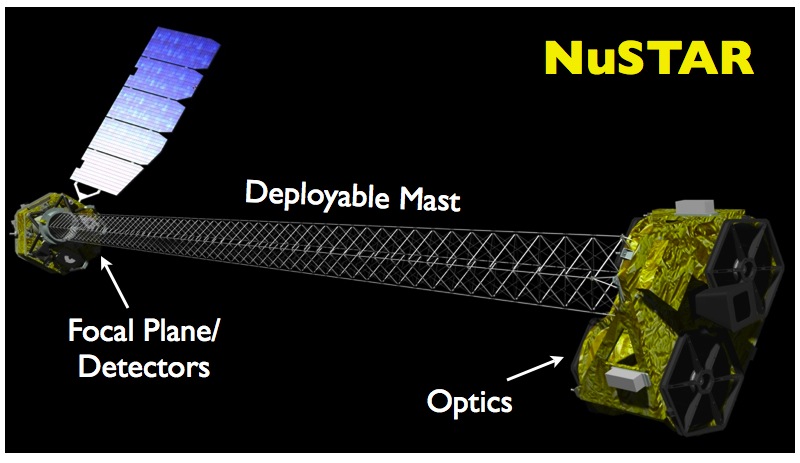The Nuclear Spectroscopic Telescope Array Mission - NuSTAR
NASA's latest high-energy astrophysics observatory, NuSTAR, is the first
focusing high-energy X-ray mission, opening the hard X-ray sky above 10 keV
for sensitive study for the first time. During its mission, NuSTAR will
search for black holes, map supernova explosions, and study the most extreme
active galaxies.
NuSTAR is a Small Explorer mission led by Caltech and managed by JPL for
NASA's Science Mission Directorate. The NuSTAR Mission web site can be found
here. NuSTAR data are
being archived at the HEASARC.
Introduction to NuSTAR
NuSTAR was launched at 9 am PDT, June 13, 2012 on a Pegasus XL rocket
which was dropped
from a Lockheed L-1011 "TriStar" aircraft flying over the Pacific Ocean near
the Kwajalein Atoll.
NuSTAR is the first mission to use focusing telescopes
to image the sky in the high-energy X-ray (3 - 79 keV) region of the
electromagnetic
spectrum. Our view of the universe in this spectral window has been limited
because previous orbiting telescopes have not employed true focusing optics,
but rather have used coded apertures that have intrinsically high backgrounds
and limited sensitivity.
During its two-year primary mission phase, NuSTAR has been observing
selected regions of the sky in order to:
- Probe obscured active galactic nucleus (AGN) activity out to the peak
epoch of galaxy assembly in the universe (at z <~ 2) by surveying selected
regions of the sky;
- Study the population of hard X-ray-emitting compact objects in the Galaxy
by mapping the central regions of the Milky Way;
- Study the non-thermal radiation in young supernova remnants (SNR), both
the hard X-ray continuum and the emission from the radioactive element
44Ti;
- Observe blazars contemporaneously with ground-based radio, optical, and
TeV telescopes, as well as with Fermi and Swift, so as to constrain the
structure of AGN jets; and
- Observe line and continuum emission from core-collapse supernovae in the
Local Group, and from nearby Type Ia events, to constrain explosion models.
NuSTAR Guest Observer Program: NuSTAR has been approved to continue operations through 2025 (subject to further extension by the 2025 NASA Astrophysics Senior Review of Operating Missions) and to
have a Guest Observer (GO)
Program. Further information about GO proposals is available on the NuSTAR Proposals page.
NuSTAR Users' Committee: The
NuSTAR Users' Committee (NUC) is a group of 5-10 astrophysicists
representing a wide range of community interests who provide the NuSTAR
project with broad-based input about the needs and priorities of the NuSTAR
user community during the extended operational mission phase.
The NUC is the primary interface between the NuSTAR community and the NuSTAR
project and NASA headquarters and assists the NuSTAR Principal Investigator
and Project Scientist during NuSTAR's operational phase and in preparation
for future Senior Reviews.
NuSTAR Announcement E-mail List: If you would like to receive NuSTAR announcement e-mails please send an e-mail with 'subscribe' in the subject to nustargo-join -at- lists.nasa.gov. If you no longer wish to receive NuSTAR
announcement e-mails please send an email with 'unsubscribe' in the subject to nustargo-leave -at- lists.nasa.gov.
NuSTAR Helpdesk: If you have questions regarding NuSTAR, concerning, e.g., calibration, analysis, proposing, ToOs, or coordination, please
use HEASARC's Feedback form
, or click
the "HELP" icon to the left.
|

|
Latest News
|
- NuSTAR Caldb Update (16 Apr 2025)
The NuSTAR FPM caldb was updated to version 20250415. This release includes a new clock correction file, v203 using a new temperature model. Please see the release notes for more details.
- NuSTAR Caldb Update (07 Apr 2025)
The NuSTAR FPM caldb was updated to version 20250331. This release includes a new clock correction file, v202 using a new temperature model. Please see the release notes for more details.
- NuSTAR Caldb Update (18 Mar 2025)
The NuSTAR FPM caldb was updated to version 20250317. This release includes a new clock correction file, v201. Please see the release notes for more details.
- NuSTAR Caldb Update (10 Mar 2025)
The NuSTAR FPM caldb was updated to version 20250303. This release includes a new clock correction file, v200. Please see the release notes for more details.
- NuSTAR Caldb Update (04 Mar 2025)
The NuSTAR FPM caldb was updated to version 20250224. This release includes a updated ARF files for FPMA, and an updated bad pixel file for FPMB. Please see the release notes for more details.
+RSS [What is this?]
Recent News
|
For those interested in general
astronomy/astrophysics information please go to our Education and Public Outreach site.
|